Still Top Gun? What Tom Cruise’s new movie tells us about American power

Simply sign up to the Life & Arts myFT Digest -- delivered directly to your inbox.
Tom Cruise’s latest blockbuster, Top Gun: Maverick, arrived in movie theatres this week with impeccable geopolitical timing. President Joe Biden met leaders from Australia, Japan and India in Tokyo on Tuesday, having earlier visited South Korea. The US president aimed to reassure partners about his nation’s commitment to their region, even as US attention is drawn ever more towards a bloody and lengthening war in Ukraine.
What better moment, therefore, for a display of vulgar American soft power to roll into global multiplexes, offering a clear vision of the longevity and vitality of US military prowess?
The original Top Gun, released in 1986, was both a box-office smash and a Reagan-era hymn to American aerial and naval might. Directed by Tony Scott, it became both the highest-grossing movie of that year and at the time among the highest in history. Its famous catchphrases — from “You can be my wingman any time” to “Negative, Ghost Rider, the pattern is full” — entrenched themselves in popular culture. And it turned Cruise into one of Hollywood’s most bankable stars, a position he has held on to doggedly pretty much ever since.
Top Gun also arrived at a moment of rising American global supremacy, giving it particular geopolitical poignancy. The film topped movie charts the year after Mikhail Gorbachev became general secretary of the Communist party of the Soviet Union, and as the balance between the two superpowers shifted decisively in America’s favour. With the bruises of defeat in Vietnam all but healed, the mid-1980s marked the start of a long period of US dominance, all held together by the kind of enduring military might that Cruise’s cinematic alter ego confidently represented.
The film had particular resonance in Asia too, right from its opening shot of the USS Enterprise aircraft carrier sailing through the Indian Ocean. Its conclusion saw Cruise’s character, Pete “Maverick” Mitchell, dogfighting with MiG-28s from an unnamed enemy, but whose paint jobs looked distinctly North Korean. Now, 36 years later, as the US readies itself for a new era of military competition with China, it would be reasonable to expect Cruise’s sequel to brim with comparable, jingoistic self-confidence. Curiously, then, it turns out that Top Gun: Maverick is actually a rather anxious kind of blockbuster, filled with doubts about the durability of US power, and functioning in many ways as an elegy for relative American decline.
Self-doubt is not what cinemagoers expect from Cruise. And indeed, on the surface, his sequel displays much of the same cocky masculinity as its predecessor. Reunited with his bomber jacket, aviator sunglasses and Kawasaki Ninja motorbike, Cruise finds himself recalled to teach at “TOPGUN”, more formally known as the US Navy Strike Fighter Tactics Instructor programme, an elite pilot school in Miramar, California.
Despite his undoubted piloting skills, Maverick’s rank does not seem to reflect this, a fact lamented early in the film by one exasperated superior, played by Ed Harris. “You can’t get a promotion, you won’t retire, and, despite your best efforts, you refuse to die,” Harris complains. “You should be at least a two-star admiral by now. Yet here you are: captain. Why is that?” Cruise flashes a grin. “It’s one of life’s mysteries, sir.”
It is best not to think too much about the film’s plot, which involves Cruise training a new generation of aviators to defeat a nameless rogue state bent on nuclear weapons. As Maverick noted in the first film, “You don’t have time to think up there. You think . . . You’re dead.” More important for most moviegoers are the flying sequences, which are indeed exhilarating. Cruise is noted in Hollywood for his commitment to realistic action, taking on scenes other actors would hand to stunt doubles. In the Mission: Impossible franchise he jumps from buildings and hangs off planes. Here he by all accounts coached his co-stars through punishing flights in jets flown by military pilots, leaving the actors’ faces contorting with g-force. “We’re working with the Navy,” Cruise said in San Diego at the film’s recent premiere aboard the aircraft carrier USS Midway. “All of the flying you see in this picture is real.”
Yet the reality you see in Top Gun: Maverick is notable less for its fantasy of US strength and more for its themes of anxiety. Part of this involves Cruise himself. In the original he was 24. Now he is 59, albeit remarkably well preserved for a man near pensionable age. Carefully placed camera angles allow him to hold his own in a game of American football with men half his age — a paean to the first movie’s celebrated shirtless beach volleyball scene, now viewed as a homoerotic classic.
Even so, there is no disguising Cruise’s advancing years. Much the same is true for Val Kilmer, who reprises his role as Tom “Iceman” Kazansky, except this time he plays an ailing admiral in the last throes of life. The film is a reasonably chaste affair, but its occasional love scenes also have something of the Viagra commercial about them. Cruise is an icon of American masculinity and his declining prowess unavoidably recalls a time when both he and his country were younger and more vital. It is clear that something has been lost.
I saw Top Gun: Maverick at its recent premiere in Singapore, sitting in a packed theatre filled with enthusiastic uniformed US servicemen, who cheered as the opening credits rolled and the easily recognisable score sprang to life. Speaking just before the film, and sporting some Top Gun-style aviator sunglasses of his own, Jonathan Kaplan, US ambassador to Singapore, linked it directly to the role the US and its military play as guardians of the “rules-based order” in Asia. Many thousands of US sailors and naval pilots work throughout that region, Kaplan suggested, to “ensure peace, security and a free and open Indo-Pacific”. Cruise’s character was always a curious vessel for this kind of rule-abiding American power, not least given his unwillingness to follow orders. Yet the first film’s premise remained that men like Maverick allowed the US and its military to patrol and control the world.
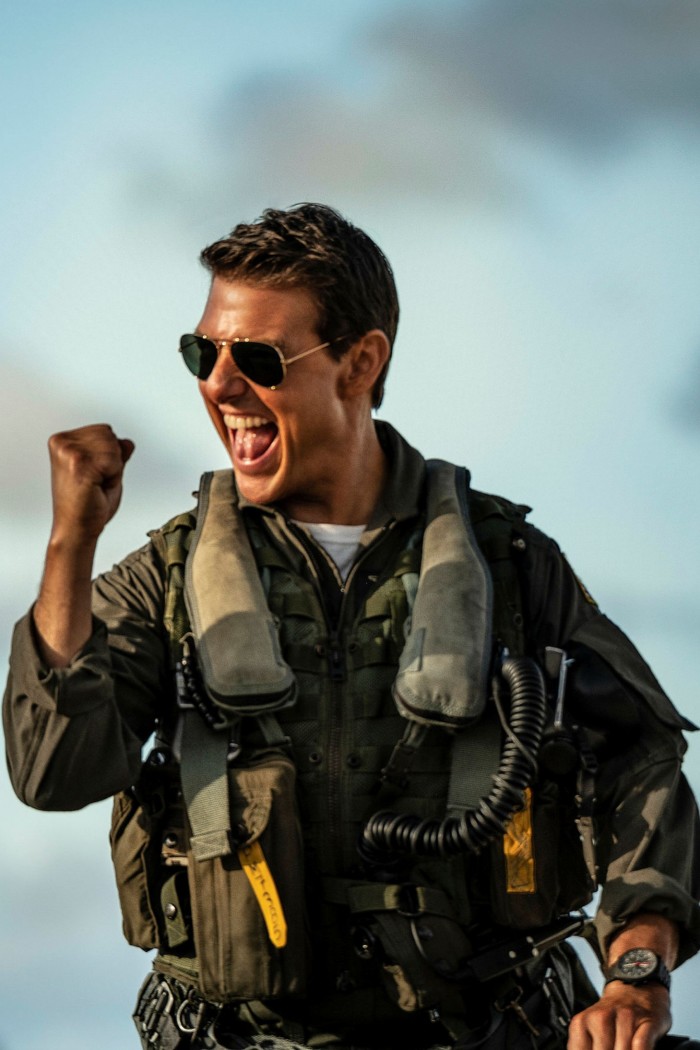

In the sequel, all this seems less certain, both because of worries about America’s declining technological prowess and the obsolescence of pilots like Maverick in the first place. The film’s opening sequence features Rear Admiral Chester “Hammer” Cain, played with gravelly élan by Harris. Dubbed “the drone Ranger”, Cain wants to replace ace pilots with autonomous air-strike capabilities powered by artificial intelligence. “The future is coming,” he tartly puts it to Maverick. “And you’re not in it.”
This is not entirely accurate, given traditional air power will still have an important role to play in any plausible conflict involving US forces in Asia. Only this week China and Russia both flew strategic nuclear-capable bombers close to Japan, seemingly in a show of strength designed to respond to Biden’s arrival in Tokyo, which Beijing and Moscow viewed as a provocation.
But the vision of a drone-powered future is hardly science fiction either, as the successes of Turkey’s Bayraktar TB2 drones above Ukraine can attest. Indeed, Harris’s character reflects the ambitions of many in the US defence establishment, who view rapid investment in military technologies as the US’s best route to maintaining its current military dominance.
There is a wider point here too. Elbridge Colby worked in the Pentagon as deputy assistant secretary of defence, helping to write the influential 2018 National Defense Strategy, which shifted US strategy away from a focus on terrorism and towards a new era of great-power competition.
“We should welcome the return of Top Gun, because it is a vision of what we actually need in US defence,” he explains. “War movies in the 2010s were all set on Afghan hilltops or the streets of Baghdad. But we are now in an era where the US must invest in new technology, but where we also need to be sending more aircraft carriers and planes to the Indo-Pacific to help deter a rising China.”

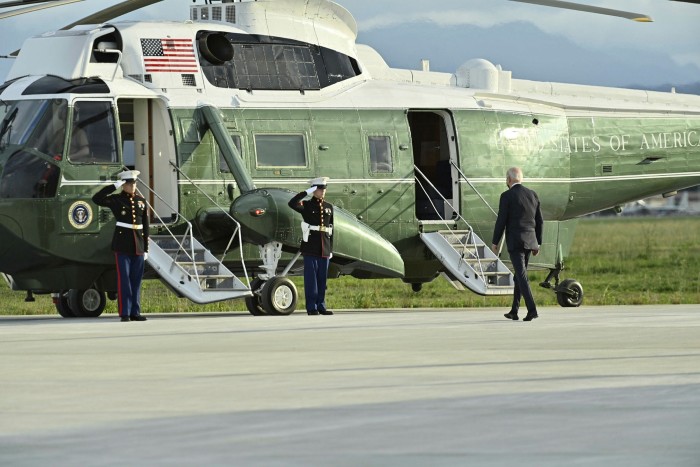
Many US strategists hope their country can repeat its successes in the 1980s, which Colby describes as “the most successful decade in American military history”. That decade involved heavy investment in military prowess, and ended in the collapse of its Soviet rival. “The appeal of Top Gun is that we want to be strong — not for its own sake, but rather to secure a good peace,” he says. “So yes, we do need new drones, but we need to invest in many other things too.”
Unspoken in the movie is the fact that it may well be China, the world’s leading drone maker, that prevails in any coming technological contest for the future of air power. Yet similar themes of technological anxiety and incipient military decline do pop up in other places.
Where the original Top Gun featured Cruise flying a now-aged F-14 Tomcat, its sequel mostly involves F/A-18 Super Hornets, a more recent model of jet introduced in the late 1990s. Yet from the start Cruise and his students are warned that their unnamed enemy is likely to have “fifth-generation” aircraft, meaning advanced planes developed in the past decade or so. While the film does not feature Chinese aircraft, the People’s Liberation Army Air Force is one of few global militaries to build such planes — beyond, of course, the US itself. China’s most advanced such plane, the J-20 stealth fighter, known as the “‘Mighty Dragon”, often patrols skies over the South China Sea, including the Taiwan Strait, an important potential flashpoint for a future conflict between the superpowers.
Of course, Top Gun: Maverick does not dare to pit Cruise against actual Chinese adversaries. Rather, the film was made with Chinese sensitivities firmly in mind. Tencent Pictures, a film distributor and production group owned by the Shenzhen-based technology giant, announced that it was investing in Top Gun: Maverick in 2019; it pulled out quietly later that year, according to a report in the Wall Street Journal this week. Sharp-eyed observers quickly noted that even the film’s trailer seemed to have been tailored to avoid causing offence in Beijing. Initial clips emerged in 2019 — the film’s release date was much delayed because of Covid-19 — showing Cruise donning the same bomber jacket he wore in the original. This time, however, two patches on the back of the jacket showing Japanese and Taiwanese flags had been replaced with ambiguous symbols of a similar colour, a change widely assumed to be introduced to avoid even the chance of annoyance by vigilant Chinese censors.
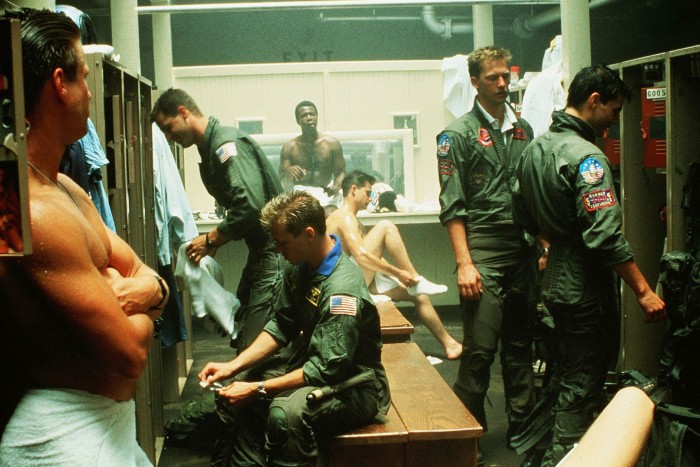
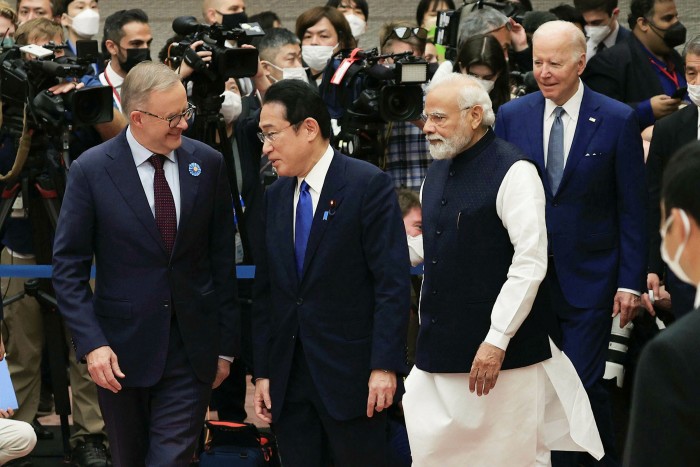
Top Gun: Maverick is hardly alone in avoiding material that might go down badly either with China’s government or its moviegoing public. A similar fate befell the recent James Bond outing No Time to Die, and indeed any number of action films where a Chinese villain might have added a frisson of geopolitical realism. Hollywood executives have long declined to portray Chinese characters as enemies, given the risk of decoupling themselves from the country’s vast film market. Indeed, you have to go back more than two decades, to 2001’s Spy Game (also directed by Tony Scott), to find a major Hollywood release that even hints at portraying China’s government in a bad light. Looked at more charitably, this decision could be seen to avoid needlessly fanning the flames of a future conflict. Yet the result leaves Top Gun: Maverick with realistic action sequences and entirely phoney international relations. A film so fearful of even naming its most likely enemy clearly lacks the kind of confidence Cruise is meant to embody.
Top Gun: Maverick is also far from alone in fearing US technological eclipse in the face of rapid Chinese advances. Similar themes were prominent in 2034, a recent novel written by military veteran Elliott Ackerman and James Stavridis, a retired four-star US admiral. Free of the self-censorship of Hollywood, the authors were at least able to imagine what might happen during a future potential Sino-US clash over Taiwan. Early on they envision an advanced “fifth generation” US F-35 aircraft being hijacked and taken over by cyber-intruders, while elite Chinese hackers end up paralysing the entire US government. Throughout the book, excessive US reliance on technology is revealed as a weakness that its even more technologically astute rivals are able to exploit.
Similar themes leave Top Gun: Maverick largely as an exercise in nostalgia, in which old-fashioned pilots flying traditional planes end up proving their worth against the odds. Such nostalgia is something its audience will probably welcome, not least because most of those who warmed to the first film in their teens are now, like Cruise, comfortably into their fifties. Yet militarily such a vision is increasingly an anachronism. Dogfighting between military jets almost never occurs in modern combat. Most military planners looking at conflicts in Asia are dead set on a vision of future warfare loaded up with new technology. The future is indeed coming, and cocksure naval aviators landing fast jets on aircraft carriers will play a far less important role than once they did.
The film harks back to a simpler geopolitical era too, when the US was a dominant power with no near peer. Today, rather than a declining Soviet Union, it faces two determined adversaries in China and Russia. As the Pentagon’s 2018 National Defense Strategy noted: “The central challenge to US prosperity and security is the re-emergence of long-term, strategic competition by . . . revisionist powers.”
Facing such a challenge, the US is becoming a more anxious kind of superpower, worried about its own relatively declining strength. Both in its ageing male lead and old-fashioned kit, Top Gun: Maverick gives an oddly accurate sense of this US vulnerability. Cruise remains a charming and watchable figure, and one who tries hard to show that both he and his country remain the force they were in their prime. Few movie-goers — be they in Beijing or Washington DC — are likely to be convinced.
James Crabtree is the Singapore-based executive director of the International Institute for Strategic Studies — Asia
Data visualisation by Ian Bott and Liz Faunce
This article has been amended since original publication to reflect Pete ‘Maverick’ Mitchell’s rank in the first ‘Top Gun’ movie, and updated to reflect reports that Tencent pulled out of its investment in ‘Top Gun: Maverick’ in 2019
Find out about our latest stories first — follow @ftweekend on Twitter
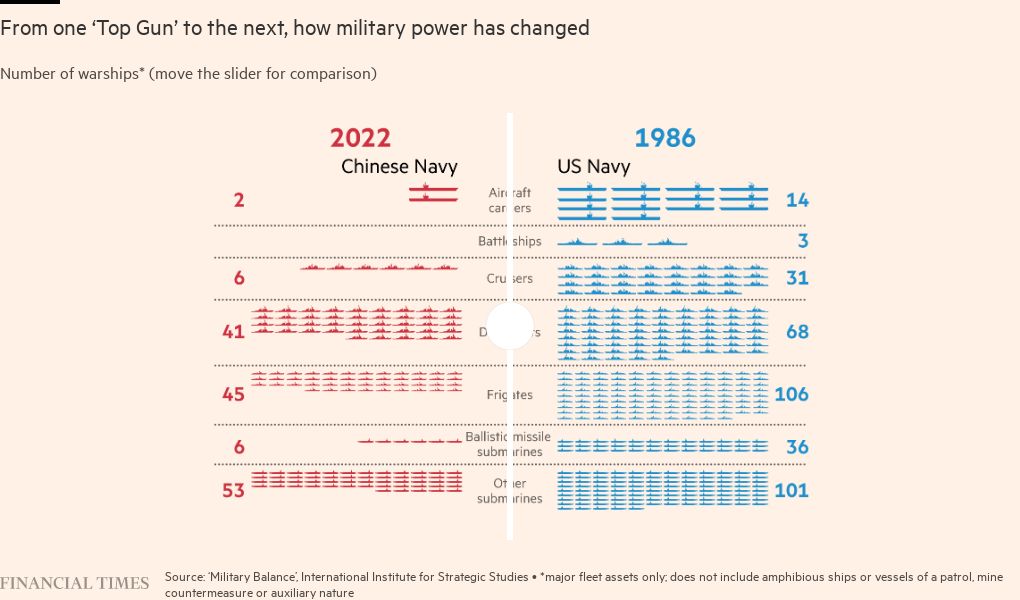
Comments